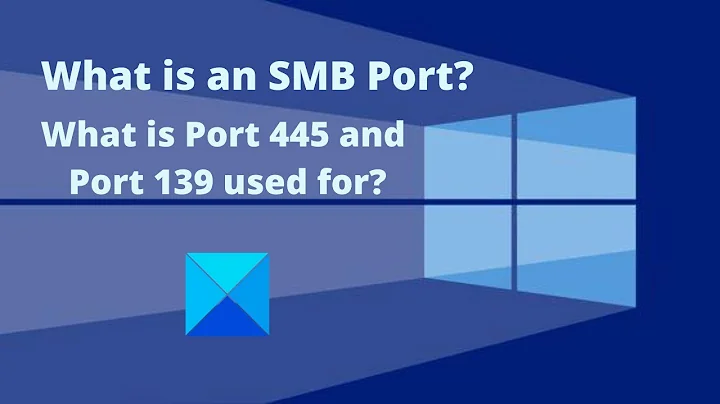TCP/IP ports necessary for CIFS/SMB operation
Solution 1
Ports 137-139 are for NetBios/Name resolution. Without it you will have to access machines by IP address opposed to NetBIOS name. Example \\192.168.1.100\share_name opposed to \\my_file_server\share_name
So port 445 is sufficient if you can work with IP addresses only.
Solution 2
This configuration worked for me: 137/UDP, 138/UDP, 139/TCP and 445/TCP. Source and additional information at: http://www.icir.org/gregor/tools/ms-smb-protocols.html.
So these are the iptables rules for my Samba server:
# The router doesn't need SMB access.
-A INPUT -s 192.168.1.1 -p udp --dport 137 -j REJECT
-A INPUT -s 192.168.1.1 -p udp --dport 138 -j REJECT
-A INPUT -s 192.168.1.1 -p tcp --dport 139 -j REJECT
-A INPUT -s 192.168.1.1 -p tcp --dport 445 -j REJECT
# Actual Samba ports
-A INPUT -s 192.168.1.0/24 -m state --state NEW -p udp --dport 137 -j ACCEPT
-A INPUT -s 192.168.1.0/24 -m state --state NEW -p udp --dport 138 -j ACCEPT
-A INPUT -s 192.168.1.0/24 -m state --state NEW -p tcp --dport 139 -j ACCEPT
-A INPUT -s 192.168.1.0/24 -m state --state NEW -p tcp --dport 445 -j ACCEPT
Related videos on Youtube
Dora
Updated on September 18, 2022Comments
-
Dora almost 2 years
I'm totally new to Tkinter, so apologies if I'm saying something really wrong. I am implementing game fifteen in Python, which I wanna make visual with Tkinter. See the following board of 2x2:
4 3
2 xIf you prompt x to swop with 3, those labels should be updated.So far I initialised a canvas, and have two code snippets, one to set up the board:
def visualize(): for i,row in enumerate(board): for j,column in enumerate(row): L = Label(root,text=' %s '%board[i][j],bg='pink') if board[i][j] == d*d: L = tk.Label(root,text=' ')And for the move function:
def move(): tile = int(raw_input('Which tile would you like to move: ')) global board, blankx, blanky for i in range(d): for j in range(d): if(board[i][j] == tile): if(i - 1 == blanky or i + 1 == blanky or j - 1 == blankx or j + 1 == blankx): board[i][j] = d * d board[blanky][blankx] = tile blanky = i blankx = j return True return FalseAny ideas on how to incorporate the labels into my canvas, and how to incorporate move as a valid event on the canvas? Thanks a lot
-
Jonathan over 12 yearsAt my site, NetBIOS names are always the same as DNS names. So if I refer to machines by hostname, will Windows be able find the machine through DNS without using NetBIOS?
-
 Tim over 12 yearsAs long as you have functioning DNS available to the client it should suffice.
Tim over 12 yearsAs long as you have functioning DNS available to the client it should suffice. -
Dora over 8 yearsThanks a lot, this is really useful! I was wondering whether you know how I could put this into a ' while won() == False: ' so that the game only goes on until the game is solved? It's not working the way I'm trying with simple including this Tkinter snippet into the loop.
-
 furas over 8 years
furas over 8 yearsmainloop()should be the only (endless) loop in Tkinter. I think you should't usewhile won() == False:. Better inmove()useif won(): print("Hurray!") -
 furas over 8 yearsI modified code to add
furas over 8 yearsI modified code to addwon()function and"Hurray"label. I useFrameto easily hide all buttons behind label. It still needsshuffle()function. -
Dora over 8 yearsThanks a lot, saved me a lot of frustration. I did it with labels in the end, and now im trying to work on resetting the board. I thought shuffle() could be the same as init where I set the values for board[i][j]. But it seems like by clicking anywhere after winning, the board stays the same, however the values do go back to the initial board values. I thought after shuffling though the mainloop() will restart itself, and the board will again be set up according to the new (initial) board values. Any idea on where I'm wrong?
-
 furas over 8 yearsif you have
furas over 8 yearsif you haveboardwith new values then you have to use it to change buttons text -buttons[y][x]['text'] = board[y][x] -
 furas over 8 yearsyou can use
furas over 8 yearsyou can usetkinter.StringVar()in board to keep values and assignStringVar()toButtonusingtextvariable=instead oftext=. When you change value inStringVarin board it will change text on button. -
 furas over 8 yearsI made new version with StringVar - see new code in answer.
furas over 8 yearsI made new version with StringVar - see new code in answer. -
Dora over 8 yearsThanks for the updates! Okay, didn't work with merely updating the text label for me. I'm trying to initialize the board (that's given in yours). I want it to be according to the user's input as dimension. Not too familiar with stringvars, but I can't just append it to a list, it seems like. Can you help me with that please? Rest looks fine after the initialization
-
 furas over 8 yearsyou can use
furas over 8 yearsyou can useStringVar()as other objects. You assign it to variablesome_stringvar_text = StringVar()or append to listsome_list.append(StringVar())orsome_list.append(some_stringvar_text). But you have to useget()andset()likeprint(some_stringvar_text.get())andsome_stringvar_text.set("Hello"). If you have problem then put code on pastebin.org or ideone.com and send link (like this pastebin.com/p2KAfsHH ). -
Dora over 8 yearsThat might be a better idea:) Here it is: pastebin.com/MVXjk1fV Really appreciate your help! The messy part is the setup function. Now the board seems to be fine, but visually it doesn't show that on the window.
-
Dora over 8 yearsThanks for this, I changed a few details as it wasn't displaying, and it all works fine. Except one thing: in setup(): I say button.lower() to make it disappear once clicked, but button is a non-referenced variable. So I can't make it disappear after resetting the board. Making it global won't work either.. I just wonder why this is while button.lift() was fine in the play() method
-
 furas over 8 yearsshow code. In previous version there is no
furas over 8 yearsshow code. In previous version there is nobuttonvariable butlabeland it is reference toButton. Maybe you get error message (in console) which could help. -
Dora over 8 yearspastebin.com/B6Vq3w6R In setup() for bn.lower() I get: "global name 'bn' is not defined"
-
 furas over 8 yearsnow I see -
furas over 8 yearsnow I see -setup()have to be afterbn=Button(). Now you callsetup() before you createbn` variablem. Remove firstsetup()- leave secondsetup()- you don't have to call it twice. -
Dora over 8 yearsGooooot it!! There was an extra function call right before root = tk.Tk() ! Thank you :)
-
 furas over 8 yearscode: pastebin.com/C303uP6U . You don't need
furas over 8 yearscode: pastebin.com/C303uP6U . You don't needbuttons = []any more. You can removegame_running = Truebeforemainloop()becausesetup()setsgame_running = True -
 Samuel Harmer almost 8 years@Hrqls In theory, yes, but AFAIK opening up your SMB to the whole world is a very bad idea.
Samuel Harmer almost 8 years@Hrqls In theory, yes, but AFAIK opening up your SMB to the whole world is a very bad idea. -
 DarkMoon over 7 yearsGiven that the OP asked about Windows computers and their level of understanding of iptables is completely unknown, this would be better written out than as a completely different system's configuration file.
DarkMoon over 7 yearsGiven that the OP asked about Windows computers and their level of understanding of iptables is completely unknown, this would be better written out than as a completely different system's configuration file. -
Gabor over 5 yearsIn plain English, UDP 137 and 138, TCP 139 and 445
-
 dess over 4 years@Styne666 , totally agree. Even more: opening anything, which does not have adequate security support, to the whole Internet is generally bad idea. I would recommend to use IPsec transport mode to protect it at least.
dess over 4 years@Styne666 , totally agree. Even more: opening anything, which does not have adequate security support, to the whole Internet is generally bad idea. I would recommend to use IPsec transport mode to protect it at least. -
 Feriman over 3 yearsIf you are access to this remote machine with DDNS, allow only TCP 445 because it's enough. I tested it today and works well.
Feriman over 3 yearsIf you are access to this remote machine with DDNS, allow only TCP 445 because it's enough. I tested it today and works well.




